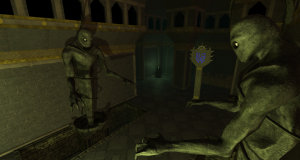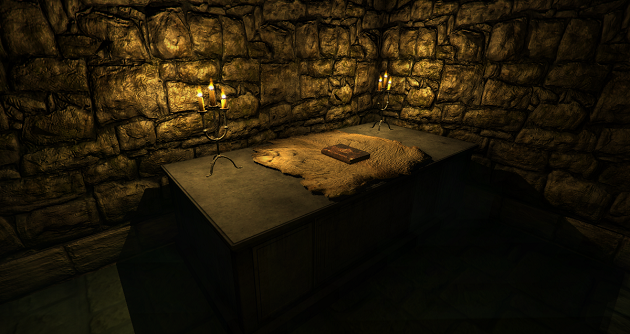Virtual reality (VR) suits the horror genre perfectly. The immersive qualities of the technology mean that, if you like getting scared, VR will be the medium to do that. While watching a film on TV at home you can see your living room and talk to people, in VR however, everything can get far more intense. White Door Games has now brought this intensity to the Oculus Rift with the videogame Dreadhalls.
Sometimes the most effective form of horror isn’t what you can see, rather what you can’t. It’s this method of delivery that the studio has gone for, creating dark dimly lit corridors and rooms to explore. Dreadhalls traps you in an ancient dungeon from which you must try to find an escape. At your disposal is a lamp and your wits, no guns or offensive weaponry of any kind exist to help you in your quest for freedom.
But before you even start to delve into the recesses of the videogame there’s the control system to grasp (or deal with), depending on your viewpoint. Controls are easy enough, locomotion is handled with the left stick on the Xbox One controller, while body orientation is handled by the right stick. A standard setup for first-person shooter (FPS) videogames viewed on a TV, but far more problematic in VR. Simulation sickness is a genuine issue with this control system, potentially making the experience uncomfortable from the very beginning. You can look around as you normally would in VR by moving your head, but the camera moves so slowly that you have to use the right stick to properly orientate yourself. This in turn creates that uncomfortable feeling some VR videogames have been known to have in years past.
Going into the option menu is advised as you’ll be able to reduce the camera rotation speed. There’s also comfort ‘snap’ feature that turn the camera in increments that does help somewhat. Simulation sickness is different for everyone – what effects some won’t even be noticeable by others – but there’s a good reason why Oculus VR has listed Dreadhalls as ‘intense’ in its Comfort Rating System.
If you can overcome these control issues then Dreadhalls has some great jump scares: seen that statue over there? Well look again as now it’s right next to you. It’s this shock factor along with the claustrophobic corridors and bleak feel that gives the videogame its presence. Enter an empty room and no matter how cautious you’ve been, look behind you and there’s tall dark figure with white piercing eyes staring right back at you.

Wandering through the different rooms searching for clues, picking up parchments revealing the story, grabbing oil for your lantern and lockpicks are the main activities you’ll be engaging in to further your progress. Whilst this is all fairly standard faire, it does make for repetitive gameplay. You might not notice at first as you invest time exploring it will soon become apparent.
There are also coins to pickup which can be spent at interactive stone heads found in random rooms. Walk up to one and you’ll see the grey stone eyes roll round to reveal pupils; after which the head will allow you to spend a designated amount of coins to ask it one of three questions offered to the player. These give you clues as to the history of the dungeon, the room you’re in and much more.
There are aspects of Dreadhalls that could’ve made it an interesting videogame, the random map generator aims to give further longevity to the main story mode, and the map feature is novel. But these won’t keep an experienced player committed; most will find one playthrough enough. There are scare’s aplenty in Dreadhalls but unfortunately not a great deal else.















